|
OVPP-Erinaceus 94 |
1944 |
7 - FLK North |
|
MAX-f, P, M |
|
104 - Unknown |
I |
upper |
3 |
Butler, P., and Greenwood, M. 1973. The early Pleistocene hedgehogs from Olduvai, Tanzania. Fossil vertebrates of Africa 3:7-42. |
|
150 - Butler and Greenwood |
|
|
Unknown |
|
Mammalia |
Lipotyphya |
|
|
Erinaceoidea |
Erinaceidae |
Erinaceinae |
|
Erinaceus |
broomi |
|
Order has more recently been determined as Insectivora |
No |
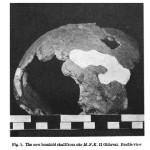 |
OH 13 |
3728 |
27 - MNK |
287 - 88 "Skull Site" |
MAN
, MAX
, CRA-f |
1963 |
122 - National Museum and House of Culture, Dar es Salaam, Tanzania |
II |
Lower Middle IIB |
5 feet above chert horizon |
|
Paratpye. "This consists of a sub-adult skull, probably female, with the third molars coming into wear. It is represented by the greater part of the mandible, including the complete dentition, although the crowns of the incisors are damaged and the left ascending ram us is not preserved; the greater part of the maxillae, represented by two fragments both lacking the anterior portions; the greater part of the occipital; the right parietal and temporal; parts of the left parietal and temporal; together with a few frontal fragments and approximately fifty additional pieces which it has not been possible to fit together" (Leakey MD, 1971:231). Specimen previously housed at National Museum of Kenya. 5 pieces found at House of Culture, Dar es Salaam, Tanzania. |
130 - L.S.B. Leakey |
|
264 - Leakey family expedition |
Yes |
|
Mammalia |
Primates |
Anthropoidea |
Haplorhini |
Hominoidea |
Hominidae |
Homininae |
Hominini |
Homo |
habilis |
|
Paratype |
No |
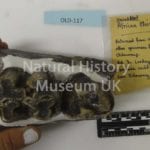 |
OLD-117 |
12407 |
|
|
MAX-f with teeth |
|
114 - Natural History Museum UK |
|
|
|
-- |
OLD-117; based on note with specimen, may not be from Olduvai |
|
|
|
Unknown |
|
Mammalia |
|
|
|
|
|
|
|
|
|
|
Rhino or Hippo |
Yes |
|
MNK Skull Site 89 |
1182 |
57 - MNK Skull |
|
MAX |
|
104 - Unknown |
|
|
|
Gentry, A. W., and Gentry, A. 1978. Fossil Bovidae (Mammalia) of Olduvai Gorge, Tanzania. Part I. Bulletin of the British Museum (Natural History): Geology 29:289-446. |
|
137 - A. Gentry |
|
|
Unknown |
|
Mammalia |
Artiodactyla |
Ruminantia |
|
Bovoidea |
Bovidae |
Alcelaphinae |
Alcelaphini |
Indet. |
|
|
This specimen is from a smaller alcelaphine than Parmularius angusticornis or Damaliscus niro. |
No |
|
HWK EE II 1972.3916 |
707 |
37 - HWK EE |
|
R-MAX, R-M |
1972 |
104 - Unknown |
II |
lower middle |
|
Gentry, A. W., and Gentry, A. 1978. Fossil Bovidae (Mammalia) of Olduvai Gorge, Tanzania. Part I. Bulletin of the British Museum (Natural History): Geology 29:289-446. |
|
137 - A. Gentry |
|
|
Unknown |
|
Mammalia |
Artiodactyla |
Ruminantia |
|
Bovoidea |
Bovidae |
Bovinae |
Tragelaphini |
Tragelaphus |
strepsiceros |
maryanus |
This specimen is rather small for later greater kudus. |
No |
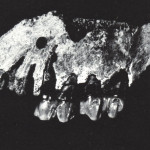 |
M. 14681 |
1313 |
|
|
L-MAX-f, L-M, L-P |
|
106 - Natural History Museum UK (?) |
II |
|
|
Hopwood, A. 1934. New fossil mammals from Olduvai, Tanganyika territory. Annals of the Magazine of Natural History. 10: 546-550. |
This specimen is pictured in plate 14b and 14c (Jolly, 1972). |
293 - A.T. Hopwood |
|
|
Unknown |
|
Mammalia |
Primates |
Anthropoidea |
Haplorhini |
Cercopithecoidea |
Cercopithecidae |
Cynocephalinae |
|
Simopithecus |
leakeyi |
|
This specimen was reclassified as aff. Theropithecus by Jolly (1972). |
No |
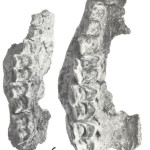 |
FLK N I 1662 |
1225 |
7 - FLK North |
|
MAX, R-P, R-M |
|
104 - Unknown |
I |
|
|
Gentry, A. W. 1966 Fossil Antilopini of East Africa. Bulletin of the British Museum of Natural History, Geology. 12: 43-106. 9 pls. |
This specimen is pictured in Gentry and Gentry (1978) plate 40, figure 6 (right) alongside specimen FLK N I 1152. |
137 - A. Gentry |
|
273 - Reck expedition |
Unknown |
|
Mammalia |
Artiodactyla |
Ruminantia |
|
Bovoidea |
Bovidae |
Antilopinae |
Antilopini |
Gazella |
wellsi |
|
This specimen was reclassified as Antidorcas recki by Gentry and Gentry (1978). |
No |
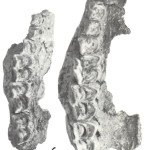 |
FLK N I 1152 |
1274 |
7 - FLK North |
|
R-MAX, R-P, R-M |
|
104 - Unknown |
I |
|
|
Gentry, A. W. 1966 Fossil Antilopini of East Africa. Bulletin of the British Museum of Natural History, Geology. 12: 43-106. 9 pls. |
This specimen is pictured in plate 40, figure 6 (left) alongside specimen FLK N I 1662. |
137 - A. Gentry |
|
273 - Reck expedition |
Unknown |
|
Mammalia |
Artiodactyla |
Ruminantia |
|
Bovoidea |
Bovidae |
Antilopinae |
Antilopini |
Gazella |
wellsi |
|
This specimen was reclassified as Antidorcas recki by Gentry and Gentry (1978). |
No |
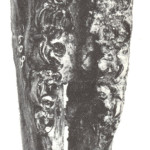 |
FLK NN I 608 |
212 |
6 - FLK NN |
|
MAN, CRA, HOR, MAX |
1960 |
105 - National Museum and House of Culture, Dar es Salaam, Tanzania (?) |
I |
middle |
1, 2, 3 |
Leakey LSB. 1965. Olduvai Gorge 1951-1961, Volume 1: Fauna and Background. New York, NY: Cambridge University Press. |
This specimen was badly cracked and weathered prior to fossilization. Other specimens are found here as well. Original information indicated that this specimen was located in Nairobi. This specimen is likely within the material that was repatriated to Dar in 2011, but this has yet to be confirmed. |
130 - L.S.B. Leakey |
|
264 - Leakey family expedition |
Yes |
|
Mammalia |
Artiodactyla |
Ruminantia |
|
Bovoidea |
Bovidae |
Alcelaphinae |
Alcelaphini |
|
|
|
This specimen was reclassified as Hippotragus gigas by Gentry and Gentry (1978). |
No |
|
OVPP-Tragelaphus 4 |
616 |
24 - DK |
|
MAX, MAN |
|
104 - Unknown |
II |
lower |
|
Leakey MD. (1971) Olduvai Gorge, Vol. 3: excavations in Beds I & II 1960-1963. New York, NY: Cambridge University Press. |
Gentry and Gentry (1978) indicate more specimens have been found at this site. |
142 - M. D. Leakey |
|
264 - Leakey family expedition |
Unknown |
|
Mammalia |
Artiodactyla |
Ruminantia |
|
Bovoidea |
Bovidae |
Bovinae |
Strepsicerotini |
Strepsiceros |
maryanus |
|
This specimen was reclassified as Tragelaphus strepsiceros maryanus by Gentry and Gentry (1978). |
No |





